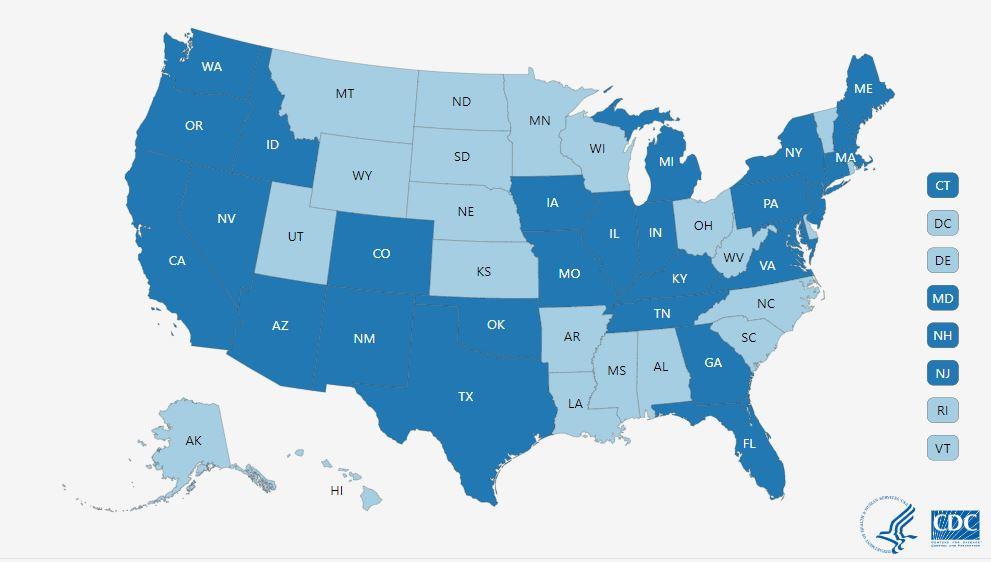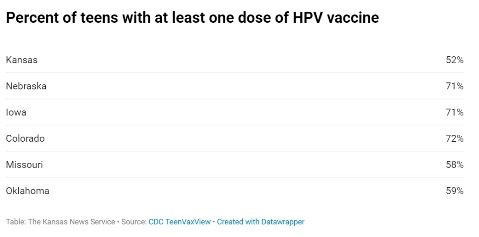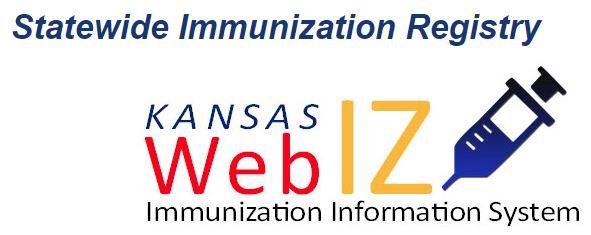by Celia Llopis-Jepsen, Kansas News Service
Editor’s note: Come back next week to read about vaccine rates in Kansas schools.
Oklahoma, Missouri, Colorado.
The national measles outbreak — numbering more than 1,000 cases so far — hasn’t hit Kansas yet, but it has crept awfully close to home.
State health officials think a case in Kansas looks nearly inevitable. And the state’s annual survey of kindergartener vaccination rates suggests some counties do better than others at getting little kids their potentially life-saving shots of MMR vaccine.
But while measles snags all the headlines, doctors, nurses, and public health workers worry not just about that, but about other vaccine-preventable diseases that rarely raise the same alarms for the public.
The best evidence suggests hundreds of thousands of Kansans lack one shot or another — or several. Those inoculations have the potential to save lives from pneumonia, cancer and other threats.
Why so many under-vaccinated people?

As best as public health experts can tell, religious objections and the anti-vaccination movement account for just a tiny sliver of the myriad reasons.
More commonly, the obstacles involve busy work lives, rural distances, poverty, spotty vaccine records, health providers with gaps in vaccine stock or limited walk-in hours, and the public’s lack of knowledge about things like adult vaccine schedules.
Vaccine schedule for adults: What shots are recommended and when?
Schedule for children/teens: What shots are recommended and when?
Every age group is affected, from infants to the elderly. Though Kansas theoretically requires shots against illnesses such as measles, whooping cough and polio for school attendance, 15 percent of kindergartners last year weren’t up to date on those.
If this all sounds dismal, some public health experts see cause for optimism.
Changing the mind of someone truly opposed to vaccines can seem daunting, even amid outbreaks of illnesses such as measles. This despite the risks of foregoing shots: hospitalization, brain damage, deafness or even death. A 105-degree fever is common with measles, Mayo Clinic says.
“They cannot be swayed,” pediatrician Barbara Pahud said. “Focus on this ginormous group in the middle …. They’re already on board for some vaccines, so there is hope if you want to see it that way.”
That “ginormous” middle group of under- or unvaccinated people greatly outnumbers those who reject all vaccines based on religion or other beliefs. Researchers peg the latter group at just 1 to 3 percent of the population, said Pahud, a specialist in infectious diseases at Children’s Mercy Hospital in Kansas City and an associate professor at the University of Kansas and University of Missouri-Kansas City.
Read about the known side effects of specific vaccines here. No evidence links vaccines to autism, a myth that got its start with a debunked academic article. Read Autism Speaks’ FAQ page on what does and doesn’t cause autism here.
Numbers speak loudly
Health is a numbers game. You can’t be certain pneumonia won’t get you, but you can reduce your risk with two vaccines against bacterial pneumonia recommended for adults ages 65 and older. Bacterial pneumonia hospitalizes hundreds of thousands of Americans a year and kills tens of thousands.
Likewise, researchers estimate inoculation against the cancer-causing HPV virus would wipe out 80 percent of the tens of thousands of cancer cases it causes across the country each year. (The vast majority of people pick up HPV at some point in their lives, though most clear it out of their bodies naturally without necessarily ever knowing.)
“Just imagine: Almost everybody knows a woman who’s had an abnormal pap smear,” said Edward Ellerbeck, chair of preventive medicine and public health at KU’s School of Medicine. “And imagine now, ‘Oh, I don’t have to worry about abnormal pap smears.’”
The HPV vaccine eliminates the number one cause of those worrying results.

Yet surveys and other sources that the federal government uses to gauge vaccine rates suggest just half of Kansas teens get even the first dose of the two-to-three dose HPV vaccine. The same problematically low rates apply to the state’s elderlyand the recommended pneumonia immunizations.
Minors without insurance, with poor-quality insurance or on Medicaid qualify for free vaccines against 16 diseases, including HPV and measles. Read more.
That frustrates groups trying to rein in the havoc these diseases wreak on our health, happiness and pocketbooks. Compared to other measures we should take to safeguard ourselves — exercise more, eat healthier, quit smoking — a shot in the arm is an easy lift.
“If there was a vaccine against breast cancer or lung cancer or prostate cancer, we’d probably run out of vaccine,” said Dan Leong, of the American Cancer Society in Kansas.
It’s tempting to conclude Kansans simply don’t want the HPV vaccine for cultural reasons. That theory seems less convincing when the best data available, though imperfect, suggest many more teens get the shots in other states. That includes nearby states with similar populations and cultural attitudes.
Checking records
It’s difficult to single out what hurdles stand between Kansans and vaccines — HPV or otherwise. Public health experts see a patchwork of barriers large and small, some of which are counterintuitive.
Last month, the Immunize Kansas Coalition launched a video campaign targeting not just parents but fellow doctors. Why? Because some physicians don’t talk to parents about the HPV vaccine. For that matter, says Wichita pediatrician Gretchen Homan, some don’t talk to patients about other vaccines, either.
Sometimes doctors assume parents will say no. Other times, they may not have the vaccines on hand.
“They don’t even pull up a vaccine record on the kids that they see,” said Homan, a professor at the KU School of Medicine in Wichita. “Because they’re not stocking those vaccines, they don’t even check the status and don’t have the conversation.”
That can leave families mistakenly thinking they’re up to date on all their shots, or that inoculation isn’t important. She encourages doctors and nurses to check vaccine records no matter what, and tell patients about locations that stock what they need.
Families, meanwhile, should feel free to ask.
“Say, ‘Hey, I’ve heard there are three vaccines due at this age,’” she said, “‘and I want to know about all of them.’”
Other hurdles
Getting a handle on the problem is tough in part because of gaping holes in what we know about who does and doesn’t get vaccines.
“Our struggle right now is really being able to know what the true vaccination rate is in any county,” said Phil Griffin, who heads immunization programs at the Kansas State Department of Health and Environment.
State and federal vaccination estimates both have their limits. Kansas calculates rates among kindergartners annually with cooperation from a solid sampling of schools that provide more precise data than some of what the Centers for Disease Control publishes.
The CDC rate calculations, though, cover a wider range of shots and age groups.
But state health officials will gradually get a better picture of immunization rates across the state in coming years. Lawmakers tightened rules for electronic vaccine records starting next year.
That same change will fill in some of the gaps for health providers who often don’t know which shots a new-to-them patient has yet to get. Doctors and pharmacists will gain more consistent access to vaccine histories, as long as the shots occurred in-state.

Griffin hopes that will boost vaccine rates. Think of a person dropping by a local pharmacy for a flu shot, for example. He or she could easily find out whether they need a pneumonia shot, too. And if so, get it then and there.
A few other efforts going on to boost vaccine rates in Kansas:
• Starting this fall, Kansas plans to phase in two more vaccine requirements (hepatitis A and meningococcal ACWY) for school attendance. Inoculation rates for both would likely increase, though the hep A rates were already fairly strong because they’re required for day care in Kansas. On Thursday, parents opposed to vaccinations protested the state’s plans at a public hearing.
• The state recently hired an epidemiologist to dig into vaccine rates across the state, is chasing grants to support the effort, and working closely with individual health providers on a regular basis to improve their practices.
• Lawmakers also recently expanded vaccine access by letting pharmacists give more shots. That may particularly benefit teenagers who no longer visit their pediatricians as often, but who still lack a number of vaccines.
Celia Llopis-Jepsen reports on consumer health and education for the Kansas News Service. You can follow her on Twitter @Celia_LJ or email her at celia (at) kcur (dot) org.
Kansas News Service stories and photos may be republished at no cost with proper attribution and a link to ksnewsservice.org.
See more at https://www.kcur.org/post/vaccine-opposition-isnt-why-many-thousands-kansans-miss-out-shots
